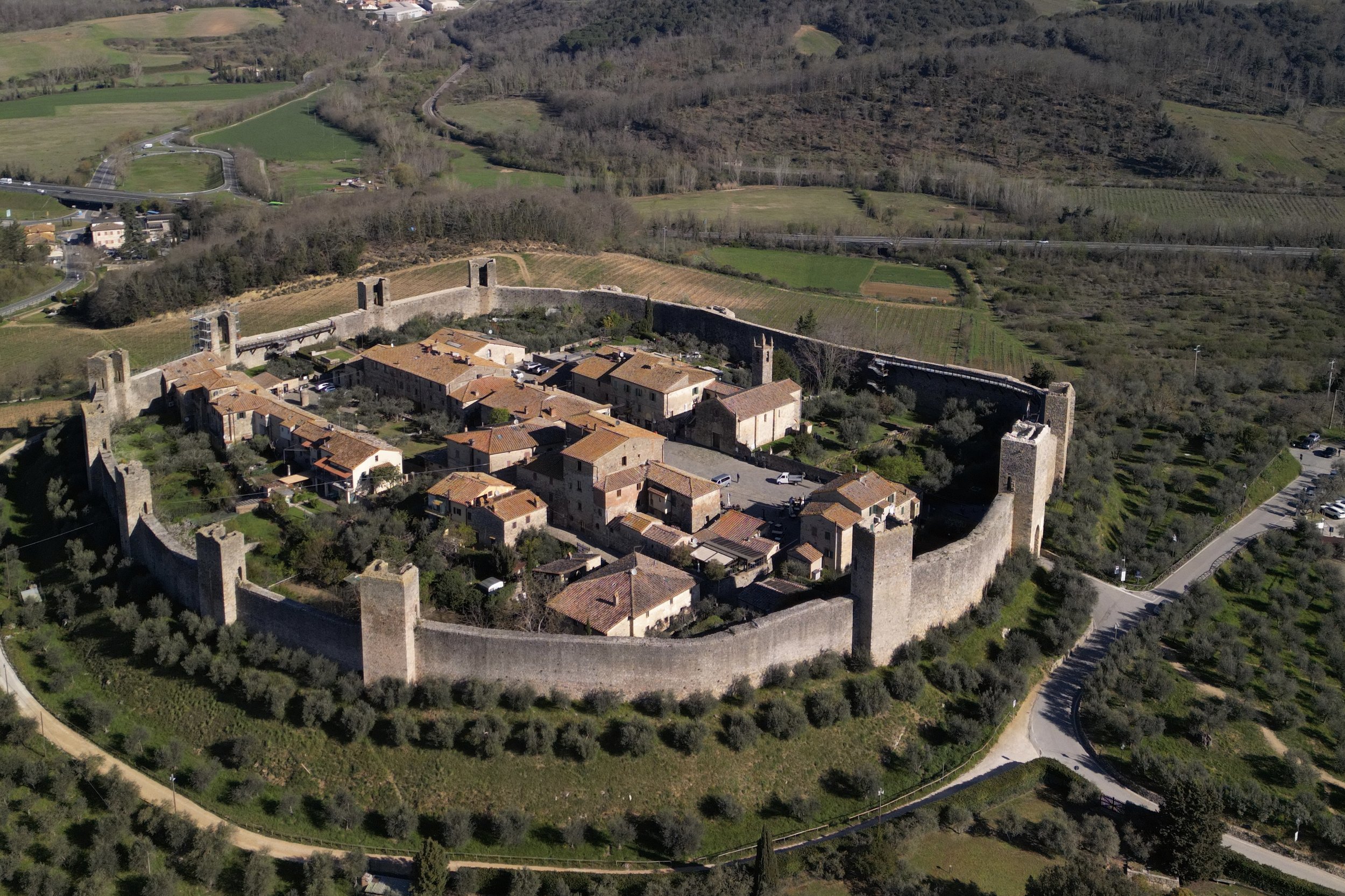Monteriggioni: one of Italy’s best-preserved medieval towns
Monteriggioni: one of Italy’s best-preserved medieval towns
Need a break from the hustle and bustle of Florence or Siena? Then why not visit Monteriggioni?! Though really small, this enchanting Tuscan town has everything to guarantee a relaxing, yet unforgettable, day trip.
The townscape of Monteriggioni is characterized by medieval a city wall and majestic, well-preserved defense towers. The whole scene could be straight out of a postcard.

Image text
I remember the first time I drove past the village. When its defense towers appeared on the horizon, I thought of a passage from Dante's Inferno. Toward the end of his journey through the underworld, Dante reaches the ledge above the bottom (the ninth circle) of hell. Here Dante takes note of what appear to be gigantic towers. He then turns to his guide Virgil to ask for the city's name. Virgil corrects Dante. They are not towers but giants! Their limbs stretch all the way down to the bottom of hell. Dante continues:
"As the fog was beginning to fade away, little by little the view became clearer, as the mist which filled the air started to disappear;
so as I looked into the dense and dark air, getting closer and closer to the well, I realized my initial mistake and became frightened;
as Monteriggioni crownes itself with towers along its circular walls,
all along the bank which surrounds the well with one-half of their bodies visible, the horrible giants stood, who Jupiter torments even now from out the heavens when he thunders."
The first two lines of this passage (canto XXXI) can also be read on a plaque outside the city wall, to the right of the Porta Fiorentina.
Today, Monteriggioni still resembles the village of Dante's era. The whole atmosphere makes it seem like time has stood still. Just go and see it for yourself!
In this guide, I will tell you more about Monteriggioni and the top things to do and see. Also, don't forget to read my post about the history of Tuscany. It might help you put some stories in perspective and get the most out of your trip.

|
How to reach? |

|
Things to do and see |

|
Google Maps, or PDF |
By car: The easiest way to get to Monteriggioni is by car. There are three parking lots. The first one (Google Maps) is located just outside the walls, only a few steps from the Porta Franca. It's a paid parking area and the most convenient one for those who don't like walking. Here you'll also find the town's public toilets.
Further down the hill is a second, larger parking area (Google Maps). From here, it's a 5-minute (uphill) walk to the Porta Franca.
The third parking lot (Google Maps) is free and located on the other side of Monteriggioni. After a 10-minute walk, you'll reach Porta Fiorentina.
By train: The nearest train station is that of Castellina Scalo (Castellina in Chianti-Monteriggioni). It's a 40-minute walk away from Monteriggioni. After exiting the train station, turn left. Here you'll find a small shed where you can rent a bicycle. On the left of the shed is a path leading to Monteriggioni.
By bus: Monteriggioni can also be reached by bus. Just hop on bus 131 from Autostazione Busitalia (timetables) next to the Firenze Santa Maria Novella train station. After about 1,5 hours, exit at Colonna di Monteriggioni. From here, it's a 10-minute walk to Porta Fiorentina.
If you're staying in Siena, catch the bus (multiple direct options) from Siena-Antiporto Camollia. It takes 40 minutes to reach the Monteriggioni Scuole stop, and another 10 minutes to walk to Porta Franca.

Image text
With its imposing tower, the city wall is Monteriggioni's main attraction. It makes the medieval fortress a true landmark. The wall has two gates that provide access to the city. Both are not to be missed. But before going into further detail, let me tell you a little more about the town's history and why the small fortress was built in the first place.
Monteriggioni's history dates back to 1213. It was strategically built by the Sienese as a defensive fortification during the conflicts between Siena and Florence. For over three centuries, the citadel withstood ferocious attacks. All thanks to its 14 large towers and two meters thick walls. But then, during yet another battle in 1554, a Florentine cannon severely damaged the town's central well.

Image text
Captain Giovannino Zeti, a Florentine exile, was head of Monteriggioni's military forces. He knew that with fresh water getting scarce, the battle was lost. And even though his men had vowed to fight to their death, Zeti decided to surrender. He slipped out in the middle of the night and headed toward the Florentine camp. Here he made a deal. If Zeti led Florentine forces into the citadel, he would get back the Florentine citizenship that had been taken from him years before. And so it happened. Not much later, Florentine troops stormed the fortress, seized control, and the Sienese army had to surrender.
Zeti's actions were considered a tremendous betrayal, and soon Zeti was tormented by his deeds. Legend has it that Captain Zeti's spirit still wanders through Monteriggioni's streets in search of forgiveness, which he will never be able to obtain.

Image text
Now back to Monteriggioni's gates. You'll most likely enter the town through the Porta Franca (Google Maps). This gate, also known as the Porta Romea, has a pointed arch and opens at the base of one of the town's large towers. While standing in front of the gate, you can see two plaques. The one on the left has an inscription commemorating Monteriggioni's foundation in 1213. The plaque on the right refers to an event in the slightly more recent past: the celebration of Italy's unification in 1861.

Image text
Image text
Monteriggioni's main street, the Via I° Maggio, connects the Porta Franca to the town's second gate: the Porta Fiorentina (Google Maps). This gate is located next to a tower and consists of a semicircular arch. Here you'll find another inscribed plaque to the right of the entrance. It's the one I mentioned earlier with a fragment from Dante's Inferno.
Image text
In the medieval period, there was a third gateway on the southwest side of the walls. Today the gate is completely walled in, and only the upper part is still visible.
I'll tell you more about Monteriggioni's city wall later. But let's explore the rest of this charming town first.

Image text
Piazza Roma (Google Maps) is the heart of Monteriggioni. The medieval architecture surrounding the square, the small stone fountain in the middle, the lack of cars, and the defense towers in the background.. Standing in Piazza Roma will magically take you back in time.
Even the orchards on the right side of the small church find their origin in the past. During the conflicts between Siena and Florence, these gardens were used to feed Monteriggioni's inhabitants in case of siege.

Image text

Image text
Today the various restaurants and bars around the picturesque square seem to have taken over the orchards' function.
It makes Piazza Roma the perfect place to enjoy lunch or have a drink in the late afternoon. Want to try something local? Order a glass of Monteriggioni's traditional red wine: Chianti Colli Senesi Monteriggioni.
Image text
As you'll notice, Piazza Roma is dominated by a small church. It's the Chiesa di Santa Maria Assunta, or Church of Saint Mary (Google Maps). The church was built around the same year as the foundation of the fortress and is the building that best preserves the town's medieval character. Only the church's bell tower was added later, around the end of the 18th century.

Image text
The interior of the Santa Maria Assunta consists of a single rectangular nave that was renovated in modern times. It now has plastered walls and vaulted ceilings. On the left wall is a 17th-century painting of the Madonna and Rosary by Lippo Vanni. The church also houses a bell donated by the Republic of Siena in 1298.

Image text
Image text

|
|
Planning to visit Monteriggioni with kids? Make sure to add Monteriggioni in Arms (Google Maps) to your itinerary. It's a small medieval museum with four exhibition rooms. Each room is devoted to a specific moment in the town's history. The items on display vary from medieval and Renaissance weapons and armor to models of siege engines. The information panels are in English (and Italian) and help you understand the military history of Monteriggioni.

Image text
Image text
If you're planning to visit the city walls as well, then my advice is to get a €4,- combi ticket. Also, please note that the opening hours (of both the museum and wall) vary per season and may even be closed for several days/weeks.

Image text

|
|
I saved the best for last. The Cinta Muria (city wall) of Monteriggioni. The ring-shaped wall extends over 570 meters, all the way around the top of the hill on which the town is built. It's interrupted at intervals by 14 rectangular towers, of which only 11 remain intact. Given that Dante mentioned Monteriggioni in his Divina Comedia and compared the towers with giants, the whole must have made a great impression in the medieval period. But that's not all. The military architecture must have also inspired the people at Ubisoft. Because as gamers among us will know, Monteriggioni appears in the popular computer game Assassin's Creed.

Image text
Two sections of the Cinta Muria are open to the public. The largest section (Google Maps) can be reached via the stairs next to Porta Romea. Unfortunately, this section is temporarily closed due to restoration works.
The second, much smaller section (Google Maps) is accessible via the stairs near Porta Fiorentina. From the top, you can enjoy the scenic view of Monteriggioni's medieval houses, Montagnola Senese, and Chianti.

Image text
As I mentioned earlier, you need a ticket to climb the walls. A ticket costs €4,- and grants you access to the Monteriggioni in Arms museum as well. Also, please note that the opening hours (of both the museum and wall) vary per season and may even be closed for several days/weeks.
Image text

|
|
Other day-trips in Tuscany

